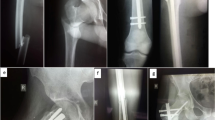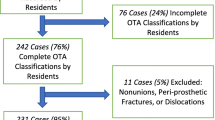Abstract
Background
The global burden of injury is receiving recognition as a major public health problem but inadequate information delays many proposed solutions. Many attempts to collect reliable data on orthopaedic trauma have been unsuccessful. The Surgical Implant Generation Network (SIGN) database is one of the largest collections of fracture cases from lower and middle income countries.
Questions/purposes
We describe the information in the SIGN database then address two questions: In the context of the design and implementation of a global trauma database, what lessons does the SIGN database teach? Does the SIGN program have a role in the evolution of a wider global system?
Methods
The SIGN database is Internet based. After treating a patient with a SIGN nail surgeons enter radiographs and details of the case.
Results
Over 26000 cases are in the SIGN database. The database has been used as a source of cases for followup studies. Analysis shows the data are of sufficient quality to allow studies of fracture patterns but not for outcome studies or bone measurement.
Where do we need to go?
A global database with more comprehensive coverage of injuries, causes, treatment modalities and outcomes is needed.
How do we get there?
The SIGN database itself will not become a global trauma database (GTD) but the personnel of the SIGN program have much to offer in the design and adoption of a GTD. Studies of suitable methods of data collection and the incentive to use them are required.

Similar content being viewed by others
References
Aharonson-Daniel L, Avitzour M, Giveon A, Peleg K. A decade to the Israel National Trauma Registry. Isr Med Assoc J. 2007;9:347–351.
Al Naami MY, Sadik AA, Adam MA. Evaluation of trauma registry data in Asir region. Saudi Med J. 2001;22:438–443.
Alexander I. The impact of future trends in electronic data collection on musculoskeletal research and evidence-based orthopaedic care. Arthroscopy. 2003;19:1007–1011.
Begg S, Tomijima N. Global Burden of Injury in the Year 2000: An Overview of Methods. Geneva, Switzerland: World Health Organization; 2006:1–22.
Burman W. The Trauma Register Experience - A Quest for Better Quality Data through Direct Physician and Patient Structured Data (i.e. point-and-click, menu-driven) Entry. Available at: http://www.hwbf.org/oko/. Accessed May 3, 2010.
Davey TM, Pollard CW, Aitken LM, Fitzgerald M, Bellamy N, Cass D, Danne PD, Griggs WM, Cameron PA, Atkinson RN, Hamill J, Rao S, Richardson DB, O’Connor C. Tackling the burden of injury in Australasia: developing a binational trauma registry. Med J Aust. 2006;185:512–514.
Demyttenaere SV, Nansamba C, Nganwa A, Mutto M, Lett R, Razek T. Injury in Kampala, Uganda: 6 years later. Can J Surg. 2009;52:E146–E150.
Fantus RJ, Fildes J. NTDB data points: NTDB breaks the 1 million record mark. Bull Am Coll Surg. 2005;90:39.
Feibel R, Zirkle LG Jr. Use of interlocking intramedullary tibial nails in developing countries. Tech Orthop. 2009;24:233–246.
Gosselin RA. The increasing burden of injuries in developing countries; direct and indirect consequences. Tech Orthop. 2009;24:230–232.
Gosselin RA, Heitto M, Zirkle LG Jr. Cost-effectiveness of replacing skeletal traction by interlocked intramedullary nailing for femoral shaft fractures in a provincial trauma hospital in Cambodia. Int Orthop. 2009;33:1445–1448.
Hansen E, Bozic KJ. The impact of disruptive innovations in orthopaedics. Clin Orthop Relat Res. 2009;467:2512–2520.
Harrast JJ, Poss R. The value and promise of patient databases in orthopaedic surgery. J Bone Joint Surg Am. 2000;82:1506–1509.
Hippocrates, Winslow & Babbage Foundation. Orthopaedic Trauma Data Entry. Available at: http://www.hwbf.org/ota/trdemo/trdx.htm. Accessed May 3, 2010.
Ikem IC, Ogunlusi JD, Ine HR. Achieving interlocking nails without using an image intensifier. Int Orthop. 2007;31:487–490.
Karbakhsh M, Zandi NS, Rouzrokh M, Zarei MR. Injury epidemiology in Kermanshah: the National Trauma Project in Islamic Republic of Iran. East Mediterr Health J. 2009;15:57–64.
Kobusingye OC, Lett RR. Hospital-based trauma registries in Uganda. J Trauma. 2000;48:498–502.
Lefaivre KA, Guy P, Chan H, Blachut PA. Long-term follow-up of tibial shaft fractures treated with intramedullary nailing. J Orthop Trauma. 2008;22:525–529.
Marsh JL, Slongo TF, Agel J, Broderick JS, Creevey W, DeCoster TA, Prokuski L, Sirkin MS, Ziran B, Henley B, Audigé L. Fracture and dislocation classification compendium—2007: Orthopaedic Trauma Association classification, database and outcomes committee. J Orthop Trauma. 2007;21(Suppl):S1–S133.
McLellan BA. A Canadian National Trauma Registry: the time is now. J Trauma. 1997;42:763–768.
Mehmood A, Razzak JA. Trauma registry–needs and challenges in developing countries. J Pak Med Assoc. 2009;59:807–808.
Moscow Declaration: First Global Ministerial Conference on Road Safety Nov 2009. Available at: http://www.makeroadssafe.org/Documents/final_declaration_en.pdf. Accessed May 3, 2010.
Naddumba EK. Musculoskeletal trauma services in Uganda. Clin Orthop Relat Res. 2008;466:2317–2322.
Nwomeh BC, Lowell W, Kable R, Haley K, Ameh EA. World History and development of trauma registry: lessons from developed to developing countries. J Emerg Surg. 2006;1:32.
Orthopaedic Trauma Association Trauma Database. Available at: https://consulting.dataharborsolutions.com/ota. Accessed April 17, 2010.
Probst C, Richter M, Haasper C, Lefering R, Otte D, Oestern HJ, Krettek C, Hüfner T; Traumaregister der Deutschen Gesellschaft für Unfallchirurgie. Trauma and accident documentation in Germany compared with elsewhere in Europe. Chirurg. 2008;79:650–656.
Sabariah FJ, Ramesh N, Mahathar AW. National Trauma Database (NTrD)–improving trauma care: first year report. Med J Malaysia. 2008;63 Suppl C:45–49.
Saleh KJ, Bershadsky B, Cheng E, Kane R. Lessons learned from the hip and knee musculoskeletal outcomes data evaluation and management system. Clin Orthop Relat Res. 2004;429:272–278.
Samuel JC, Akinkuotu A, Baloyi P, Villaveces A, Charles A, Lee CN, Miller W, Hoffman IF, Muyco AP. Hospital-based injury data in Malawi: strategies for data collection and feasibility of trauma scoring tools. Trop Doct. 2010;40:98–99.
Schultz CR, Ford HR, Cassidy LD, Shultz BL, Blanc C, King-Schultz LW, Perry HB. Development of a hospital-based trauma registry in Haiti: an approach for improving injury surveillance in developing and resource-poor settings. J Trauma. 2007;63:1143–1154.
Shaban S, Ashour M, Bashir M, El-Ashaal Y, Branicki F, Abu-Zidan FM. The long term effects of early analysis of a trauma registry. World J Emerg Surg. 2009;4:42.
Shah RK, Moehring HD, Singh RP, Dhakal A. Surgical Implant Generation Network (SIGN) intramedullary nailing of open fractures of the tibia. Int Orthop. 2004;28:163–166.
Shah RK, Singh RP, Quasem MF, Faraquee SR, Harrison J. SIGN interlocking nail for the treatment of infected nonunion Tech Orthop. 2009;24:289–296.
Shearer D, Cunningham B, Zirkle LG Jr. Population characteristics and clinical outcomes from the SIGN online surgical database. Tech Orthop. 2009;24:273–276.
Shearer D, Zirkle LG Jr. Future directions for assisting orthopaedic surgery in the developing world. Tech Orthop. 2009;24:312–315.
SIGN Database. Available at: http://www.signsurgery.org. Accessed April 17, 2010 (registration and password available only from the SIGN program).
Spiegel DA, Gosselin RA, Coughlin RR, Joshipura M, Browner BD, Dormans JP. The burden of musculoskeletal injury in low and middle-income countries: challenges and opportunities. J Bone Joint Surg Am. 2008;90:915–923.
Taye M, Munie T. Trauma registry in Tikur Anbessa Hospital, Addis Ababa, Ethiopia. Ethiop Med J. 2003;41:221–226.
Ward E, Arscott-Mills S, Gordon G, Ashley D, McCartney T; Jamaican Injury Surveillance System. The establishment of a Jamaican all-injury surveillance system. Inj Control Saf Promot. 2002;9:219–225.
Wild M, Candrian A, Wenda K. Possibilities and limits of Internet-based registers. Inform Health Soc Care. 2009;34:81–90.
Wolfe BA, Mamlin BW, Biondich PG, Fraser HS, Jazayeri D, Allen C, Miranda J, Tierney WM. The OpenMRS system: collaborating toward an open source EMR for developing countries. AMIA Annu Symp Proc. 2006:1146.
Zafar H, Rehmani R, Raja AJ, Ali A, Ahmed M. Registry based trauma outcome: perspective of a developing country. Emerg Med J. 2002;19:391–394.
Zirkle LG Jr. Injuries in developing countries—how can we help? The role of orthopaedic surgeons. Clin Orthop Relat Res. 2008;466:2443–2450.
Zirkle LG Jr. Introduction. Tech Orthop. 2009;24:224.
Acknowledgments
We thank the surgeons of the SIGN program for their diligence in entering data into the SIGN database.
Author information
Authors and Affiliations
Corresponding author
Additional information
SIGN (Surgical Implant Generation Network) is registered as a nonprofit, tax-exempt corporation in the state of Washington and in the United States with IRS 501(c)(3) status. LGZ is the President of SIGN. RJS is employed by SIGN.
This work was performed in Canada using the SIGN database located in the United States.
Electronic supplementary material
Below is the link to the electronic supplementary material.
This file is unfortunately not in the Publisher's archive anymore: Supplementary material 3 (TIFF 62 kb)
This file is unfortunately not in the Publisher's archive anymore: Supplementary material 4 (TIFF 67 kb)
About this article
Cite this article
Clough, J.F., Zirkle, L.G. & Schmitt, R.J. The Role of SIGN in the Development of a Global Orthopaedic Trauma Database. Clin Orthop Relat Res 468, 2592–2597 (2010). https://doi.org/10.1007/s11999-010-1442-1
Published:
Issue Date:
DOI: https://doi.org/10.1007/s11999-010-1442-1




